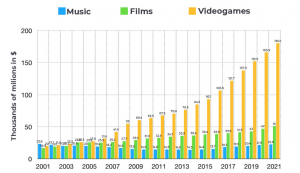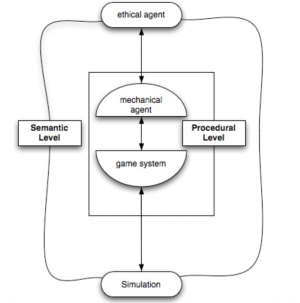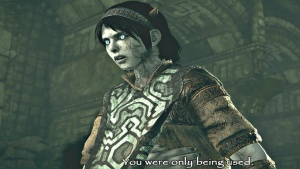Ethical game design
Ethical Game Design is the study of game elements that allow players to reflect on ethical implications of their actions and decisions within a game[1]. The rise of this field of study is influenced by video games’ growing popularity that extends through multiple demographic boundaries, and their potential educational implications to the players. The academic discussions surrounding the concept are pioneered by IT University Copenhagen Center for Computer Game Research Associate Professor Miguel Sicart. These accounts provide a deeper look into the definition of ethical gameplay, the effects of ethical game design, and challenges for ethical game design moving forward.
Contents
The Origin of Ethical Game Design
Ethical game design is a sub-branch of Computer Ethics, created after the surge in video game popularity. The growing player base has revealed unique features of cyberspace that require new ethical thoughts and consideration. Video games introduce a number of ethical concerns which require game designers to consider when creating their game.
Video Games as an Emerging Technology
James H. Moor, Professor of Intellectual and Moral Philosophy at Dartmouth College states that ethical problems dealing with specific information technologies increase as the technologies move through the three stages of a technological revolution's theoretical process. The three theoretical stages of a technological revolution are all characterized by the traits related to the device's status as a good in society, the relevance it has pertaining to the specific role it plays in the user's life, and the social impact in the user's society. [2]
James Moor warns users and designers that as technologies progress through the stages, ethical problems only increase [2]. As novel games and services arise, new ethical problems will surface that could not be foreseen, but must be challenged [2]. However, it would be effective to minimize these problems by initially designing games with an ethics mindset. Game designers have an obligation to protect their users and keep ethics in mind during every stage described by Moor. Technological revolutions have the power to extensively influence societal values and it is important to limit biases and stereotypes, which many games are guilty of reinforcing.
Technology Revolution Stages
Introduction: The earliest implementations of the technology in a user's society. The characterizations of this phase are defined by the device's presence as a point of intellectual curiosity. Within society, there is less saturation of the presence of the device. Therefore, its impact on society will be marginal and the device will take on the characteristics of high financial cost, steep learning curve, and inefficiency. [2]
Permeation: The technology becomes more standardized than the introduction stage and is introduced with a more conventional design and operation allowing a friendly interaction with normal users. This is when the technology first emerges into the infosphere. As the demand for the device increases, more attention is centered on the development of the device which lowers the cost of production for that device even though the device has not become fully saturated in society. The characterizations of the permeation stage include training courses for device use, moderate financial cost, and a moderately increasing impact of the technology on society. [2]
Power:The technology is firmly established, affecting the majority of the population directly or indirectly, which brings significant impact to society. The price of the technology is lowered due to the economy of scales and the technology can be early accessible by the majority of the population. The characterizations of the power stage include user's common knowledge of device operation, low barrier to the financial cost, and the technologies full integration into society. [2]
Within the U.S. market, the video game industry is approaching the power stage as suggested by the following statistics: 64% of U.S. households own a device that they use to play video games with and 60% of Americans play video games daily. [3] Such trends indicate a growing need to fill potential policy vacuums in the industry, and suggest that a proactive approach by scholars and policy makers is necessary as they develop ethical guidelines for the technology.
The gaming industry has been through many technological revolutions, but most recently, Apple and Google have entered the market with subscription services called Apple Arcade and Stadia. These subscriptions will either complement the industry's current business model or replace it, as gamers can now get instant access and portability using their Apple devices or the cloud. [4] One can say that the video game industry's approaching the power stage can be partially attributed to the fact that a new era of streaming is opening up games to millions, maybe billions, more people who are not paying for pricey equipment.
Video Games as Cyberspace
In video games, players interact with games’ virtual worlds through player avatars – characters that are either pre-established by game designers or characters that players create themselves. This points to the unique feature of video games as cyberspace where participants carry out their actions with the assumption that their actions have no physical consequences. The players are able to hide behind their avatar. This can lead to the player-controlled avatars becoming agents of artificial evil, because they afford players the ability to conduct actions ranging from sex, theft, and murder which can damage players’ nature and future development. [5] Outside cyberspace, players may take action as their avatars did in the game, except that the player's actions may have more severe consequences as their space is physical.
Because these issues are sufficiently novel and can bring about real world implications they call for a deeper understanding of ethical issues surrounding video games and their design.
Miguel Sicart
Miguel Sicart is an Associate Professor at the Center for Computer Game Research at IT University of Copenhagen. [6] Miguel has contributed a number of publications on the topic of ethical game design including “Beyond Choices. The Design of Ethical Gameplay” and “The Ethics of Computer Games.”[7] Miguel earned his PhD in game studies under a committee that Luciano Floridi is also apart of. [6] Because of Floridi’s influence, Miguel often uses Floridian principles in his publications on game design, including using the concept of levels of abstraction to describe different dimensions of game design.
Ethical Gameplay
On a broader level, gameplay is defined as involving a player performing strategic actions that are allowed within a rigid boundary of rules for the purpose of achieving specific goals or purposes. [8] In order to create such environments, games are designed on both procedural and semantic levels.
Procedural level game design involves the foundational architecture of the game, which involves fundamental gameplay mechanics, game rules, audio and visual elements, goals and objectives that make a game playable. Players are not required to have specific cultural or contextual knowledge to understand game design elements at the procedural level. [9]
Semantic level elements involve metaphors that are used to give deeper meanings to the procedural elements. These elements may include the prevailing tone of language spoken by characters, the ways that other characters in the virtual world are portrayed, cinematic cut scenes, and etc. These metaphors are often culturally based, because the semantic level is meant to create a sense of connection between players’ real world experiences and games’ virtual worlds. [9]
Ethical Game Design Versus Conventional Game Design
Conventional video game design follows the principle of minimizing cognitive friction. [9] It is the principle that a game’s procedural and semantic elements should work collaboratively to help players make in-game strategic decisions. An example of such collaborative process can be found in Nintendo’s The Legend of Zelda: Breath of the Wild. With the game’s dynamic weather system, game designers expect players to have the background knowledge that metal objects conduct electricity, and therefore players should store away any metal objects they possess during in-game lightning storms. Failure to do so will increase the likelihood that players’ in-game avatar will get struck by lightning which decreases the character’s health. In this scenario, the semantic element of real world environmental affects combined with procedural level element of character’s health depletion work together to inform players what optimal decisions they should make.
Unlike conventional gameplay where there is one or a limited amount of correct courses of actions that players are encouraged to take, ethical gameplay creates unique scenarios that prompt players to reflect on the ethical implications of their actions - rather than focus purely on the objectives they try to reach. As conventional video game design strives to minimize cognitive friction, ethical game design seeks to increase it. [9] Its results are characterized by players receiving imperfect information and a network of outcomes that make the consequences of decisions difficult to predict, therefore making the final decision dependent on players’ own ethical values.[8] This is an example of how ethical game design contains many aspects of value sensitive design. Ethical game designs aim to encourage the player to make informed decisions and to think actively while they are playing. This translates into the value of creating an active experience for the player. Game designers are exercising this value in an engaging and thought-provoking way by writing an algorithm that challenges players to make informed decisions in order to be successful in the game.[10]
Video Games that Employ Ethical Game Design
Fallout 3: Fallout 3 puts players in a post-apocalyptic virtual world where the standard legal system has failed. During the course of the game, players are required to make decisions that can impact the game’s world and form alliances with other characters that players encounter. However, those potential allies are characterized by their own ethical flaws. The game also never explicitly sets any moral standard that players ought to comply with, nor does it give any clues for how the ethical consequences of players’ actions can have any strategic implications.
Players are only left with their own moral compass as they venture through the wasteland.
Shadow of the Colossus: In the Shadow of the Colossus, the player controlled character embarks on a journey to hunt down 16 colossi that wonders around the game’s virtual world. Players are given minimal narrative clues other than the main objective. Game mechanics wise, with each encounter, players are required to climb onto the colossus and defeat it by attacking designated weak points. After the player succeeds in defeating a colossus, the player controlled character will go through a sequence of inevitable loss of consciousness and appear to be ill after waking up. Such sequences will repeat after the defeat of each colossus, the character will appear more ill until he ultimately dies after defeating the final colossus.
Shadow of the Colossus employs ethical game design the leads players to reflect on how the character’s acts of violence toward an idealized goal ultimate brought death and destruction upon himself. The theme of pursuing a goal that brings forth both harm and gratification is expressed through the cognitive friction produced by game’s procedural and semantic elements. Procedurally, after the defeat of each colossus, the character’s ability increases which seemingly indicate positive character progression. While on the semantic level, the way that the character appears to be increasingly ill lead players to reflect whether defeating the colossus is a good thing.[9]
Mass Effect: In the game Mass Effect, players are given numerous options when dealing with tasks and in dialogue with other characters. These decisions often end up contributing towards "paragon" points, received when the character does an altruistic action, and "renegade" points, when the player chooses unethical actions in order to achieve their goal. This constant element of choice lets the player reflect on the type of character they are trying to create in the main character. This design allows for a player to be as ethical or unethical as they wish, within a certain boundary (as it would be impossible to finish the game without combat scenarios for example). Yet this strays away from a singular method for how the player chooses to approach their character and their reputation within the game.
Telltale Games: The Telltale Games are a series of games in which the player is told a story but is tasked with making critical decisions that not only affect the characters in the game but also the story as a whole. These games take place and tell stories in a large manner of different settings ranging from the post-apocalyptic tale about a man and his want to help an abandoned girl in Telltale The Walking Dead, to a story about a werewolf cop looking for a murderer in a dark fantasy setting in The Wolf Among Us. In both of these games, and in many other games the player is given difficult questions to answer, and these questions actually serve as the basis of all gameplay within these video games. Not only do these games employ ethical game design but are completely build around them in order to create the most cognitive tension for the player. An example among many others lies within the first act of the Walking Dead Telltale game, where the player's character is given the choice of which people to feed out of the camp they are staying at. This choice is very difficult on most players as there is not enough food to go around and the players must weigh their options. There is the difficulty of whether or not to feed the child because he is a kid, or whether to feed the adults because they are the ones who can actually fight the zombies. And another issue arises if a player removes logic and chooses to feed characters simply based on who the player likes better. This choice, among many highlights the way in which Telltale games employ ethical game design as the building blocks for the games.
The Last of Us: The Last of Us is a video game set in a post-apocalyptic world ridden by an infectious fungus that has turned many people into zombie-like predators. The storyline features two protagonists: Joel, a man who lost his daughter during the start of the infections, and Ellie, a teenage girl immune to the fungus. Joel is tasked with delivering Ellie to a research group across the country that is attempting to find a cure for the disease. During their journey, players are forced to observe the extent of ill-will and greed that people display in a world lacking society that has a system for justice, including in the protagonist. Throughout the game, the player is given the choice to "stealthily" or "offensively" deal with adversaries, which does not only include infected people, but also other survivors. In other words, the player is given the choice to avoid or kill enemies, where the latter is often followed by commentary from Ellie who reacts in emotions ranging from disgust to fear[11].
As the storyline progresses, the characters develop and change significantly, the main change being the relationship between Joel and Ellie. While Joel initially treats Ellie as a "package" to be delivered, they eventually form a daughter-and-father relationship, which is implied to have been fueled by Joel's loss of his daughter, and Ellie's parentless upbringing.
At the end of the game, an ultimate ethical dilemma is presented as it is revealed that Ellie will die if the researchers develop a cure as they need to perform a fatal operation on her. Out of selfishness, Joel goes on a rampage and kills the researchers in order to save Ellie, who is unaware of this as she is sedated. When Ellie later wakes up, Joel lies to her, telling her that the researchers tried their best but were unable to find a cure. In essence, the player observes the selfishness of a man who saves one person special to him, instead of coming to terms with a choice that would save thousands, even millions, of lives.
What Ethical Gameplay is Not
It is important to distinguish the difference between ethical gameplay and games with an ethics or moral meter built in as part of the playable character’s status. The latter is a kind of gameplay mechanism popularized by video game series such as Fable and Star Wars: Knights of the Old Republic, where the player’s character has an ethic meter that affects the narrative progression and the characters’ appearances and skills during the duration of gameplay.
Such mechanisms are not considered as ethical gameplay because the game predefines ethical and unethical options for the players instead of leaving the morality of the scenario as a question for them to consider. [12] This form of gameplay comes with its own ethical implications - namely with respect to the messages that game designers (or higher-ups) are choosing to spread via moral meters.
In essence, ethical gameplay makes players responsible for their choices. [8] To achieve this, players first need to have total autonomy in their decision making process. There are no explicit punishments or rewards associated with the decision that can act as mental constraints and there are no prompts from the game system itself that can be seen as directions for players to follow. In addition, players need to be then exposed to the consequences of their actions through changes in the game’s virtual world. Effectively, ethical gameplay mirrors the decision-making processes that take place in our offline reality.
Effects of Ethical Game Design
The interactive nature of video games affects players’ development as moral agents. Shannon Vallor presented the argument that virtues are not ‘natural’ or ‘inborn’, nor are they learned simply by cognitively internalizing certain norms, but are formed from repeated engagement in activities that lead to settled habits of excellence. [13] Video games provide the environment for those activities to occur. However, depending on the nature of the aforementioned activities, players may end up developing vices instead.
Banality of evil is a concept that explains how humans can commit unspeakable acts of cruelty without remorse because there is a system in place that prevents human agents from perceiving the actual consequences of their actions. [12] Such a system currently resides in most modern video games where players are distracted by the immediate rewards and sense of accomplishment gained after killing an opponent - so much so that they give no second thought on the action of “killing” that they have committed. Through repetition of such activities, players become desensitized to violence, theft, and other unethical and immoral behaviors. [12] Even though players commit no real crime by committing those actions in a virtual environment, such mechanisms jeopardize players’ ability to evaluate the ethics of those actions.
In contrast, ethical game design takes down the veil of ignorance as players are made aware of the consequences to their actions. It stops players from viewing video games merely as environments for them to satisfy their guilty pleasures, but seeing scenarios in video games as simulations of the real world, hence inducing players to apply the same ethical values they would apply to real life scenarios to their in-game decision-making process. And through such repeated exercises, the ethical game design allows players to start forming and refining their ethical values.
Challenges for Ethical Game Design
Despite its potential benefits, ethical game design is not a common element in today’s video game market.
First, ethical game design can only be implemented within a game world if that world possess the ability to reflect moral choices. Designing such complicated game worlds requires significant resource investment which limits such projects to well-established game studios. However, even among such studios, there may be resistance to implementing ethical game design due to the philosophy of player advocacy that focuses on catering to player desires, [14] which conflicts with ethical game design where players will most likely not be fully satisfied with the end result, same with the outcomes of ethical dilemmas in the real world. Implementing ethical game design comes at the risk of losing player interest. This is usually too big of a tradeoff for video game studios and their mother companies, seeing as these companies aim to maximize revenue.
Another challenge that hinders the effect of ethical game design is the ability of a player to reverse the game state to a previously saved game state. This is made feasible by games’ saving mechanism. Most modern video games give players the option to save their progress at any point in the game. Therefore, the realism of the ethical dilemma and the impact of player choices are reduced when players can game the system by saving the game before an ethical game design scenario, which would allow them to revert their choices if they find the consequences upsetting. This ability, obviously, does not exist in the real world. As a result, players may not realize the true impact of their actions.
See Also
References
- ↑ Tkahashi, Dean (December 27, 2004). "Ethics of Game Design". Gamasutra. Retrieved April 28, 2019.
- ↑ 2.0 2.1 2.2 2.3 2.4 2.5 Moor, James (2006). "Why we need better ethics for emerging technologies", Springer, pg. 2
- ↑ Entertainment Software Association., 2018. "Essential Facts About the Computer and Video Game Industry", Entertainment Software Association, pg. 4, url: http://www.theesa.com/wp-content/uploads/2018/05/EF2018_FINAL.pdf
- ↑ MacDonald, Keza (March 27, 2019). "Apple Arcade v Google Stadia: which is the future for video games?". The Guardian. Retrieved April 28, 2019.
- ↑ Floridi, Luciano; Sanders, J.W. (2001). "Artificial evil and the foundation of computer ethics". Ethics and Information Technology. pg. 3-6
- ↑ 6.0 6.1 Sicart, Miguel. "Curriculum Vitae". Retrieved April 28, 2019.
- ↑ MIT Press, url:https://mitpress.mit.edu/contributors/miguel-sicart
- ↑ 8.0 8.1 8.2 Sicart, Miguel (2013). "Moral Dilemmas in Computer Games". The MIT Press. pg. 29-30
- ↑ 9.0 9.1 9.2 9.3 9.4 Sicart, Miguel. (2010). "Values between Systems: Designing Ethical Gameplay" Ethics and Game Design: Teaching Values through Play. pg. 4
- ↑ Friedman, Batya, Khan, Peter H., & Boring, Alan. "Value Sensitive Design and Information Systems." Human-Computer Interaction in Management Information Systems: Foundations. University of Washington.
- ↑ Tilley, Steve. “End-of-the-World Themed 'The Last of Us' Poses Moral, Ethical Questions.” Toronto Sun, 4 Feb. 2013, torontosun.com/2013/02/04/end-of-the-world-themed-the-last-of-us-poses-moral-ethical-questions/wcm/de4736f3-d170-4926-a4ea-9362a402b6e1.
- ↑ 12.0 12.1 12.2 Sicart, Miguel (2009). "The banality of simulated evil: designing ethical gameplay". Springer Science Business Media. pg. 198. Retrieved April 28, 2019.
- ↑ Vallor, Shannon (2009). "Social networking technology and the virtues". Springer Science Business Media. pp. 158. Retrieved April 28, 2019.
- ↑ Sicart, Miguel; Wilson, Douglas (2010). "Now It's Personal: On Abusive Game Design". pg. 2. Retrieved April 28, 2019.



